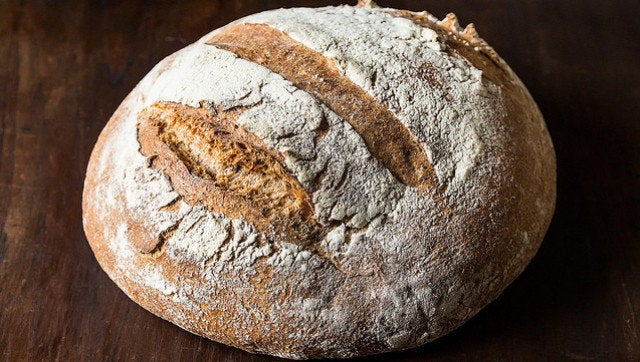
Inspired by conversations on the Food52 hotline, we're sharing tips and tricks that make navigating all of our kitchens easier and more fun. Today, we're discussing the best ways to maintain a sourdough starter.
Sourdough starters have a reputation for being high-maintenance. There are many different feeding methods out there, and the multitude of options and schedules can overwhelm. However, once you've mastered your routine, a starter is a completely manageable addition to your kitchen. And we've highlighted a method that only requires a once-a-week feeding for maintenance purposes. Of course, there are other successful strategies, but we've found this one to be manageable as well as successful.
What is it?
A sourdough starter has three components: flour, water, and wild yeast. Sourdough bread differs from other types of bread in that it contains no cultivated yeast or chemical leaveners. Rather, it gets its rise from wild yeast and Lactobacillus, a type of bacteria. The sour taste that it produces comes from lactic acid, a byproduct of the fermentation that occurs when lactobacillus metabolizes the sugars found in flour.
Like any living organism, a starter needs food in order to grow and survive. So, although it's quite resilient, it must be fed regularly in order to produce a quality product when used in baking.
Feeding your starter
The formula is simple: add equal parts water and all-purpose flour to four ounces of starter. Be sure to stir well before and after mixing -- you want to equally distribute all ingredients, gases, and liquids.
This creates a 100% hydration ratio, which means that you are using the same amount of flour and water. It is important not to feed your starter too much: it will be overwhelmed and unable to digest everything. Feeding it too little, on the other hand, can lead to an inactive starter.
Countertop Maintenance
To maintain your starter at room temperature, feed it once daily using the following formula: combine four ounces of starter, four ounces of flour, and four ounces of water.
The day before you plan to bake, feed it twice without discarding any of the starter. That is, add 4 ounces each of flour and water; you want to beef it up in both size and activity level before putting it into your dough. These two feedings should be at least six hours apart, and the second feeding should come 6-8 hours before you begin mixing your dough. This does require some planning ahead!
Refrigerator Maintenance
Here's the low-maintenance method: to maintain your starter in the fridge, simply feed it once a week: combine four ounces of starter with eight ounces each of flour and water. Then it's back into the fridge for 7 days. This is also a great method that will avoid over-fermentation if your kitchen is very hot (hello, New York City summers).
Three days before you bake, take the starter out of the fridge. Feed it once, and then let it sit at room temperature for 24 hours. The next day, feed it twice -- roughly 12 hours apart. On the third day, feed the starter about 6 hours before you mix your dough -- this will allow proper fermentation to maximize the rise and flavor of your loaves. Got that? Good. Now get baking!
You probably didn't kill it.
You might neglect your starter. You might forget about it for weeks. But it's probably salvageable! If a sour- or astringent-smelling liquid has pooled at the top (that's the alcohol from fermentation), simply mix it back in -- don't dump it out! -- and then begin feeding it twice daily. Once you start seeing those fermentation bubbles again, you're clear to resume your regular schedule.
If your starter turns pink or red (or moldy), it has gone bad. Just throw it out and start anew.
Storage Options
While a ceramic crock is the most traditional container for a starter, plastic will do just fine. Glass works, too; just be sure that your container has a wide mouth to make feeding and measuring easier.
What now? Bake some bread, and eat up!
Tell us: Do you have tips for keeping a sourdough starter? How do you enjoy sourdough bread?